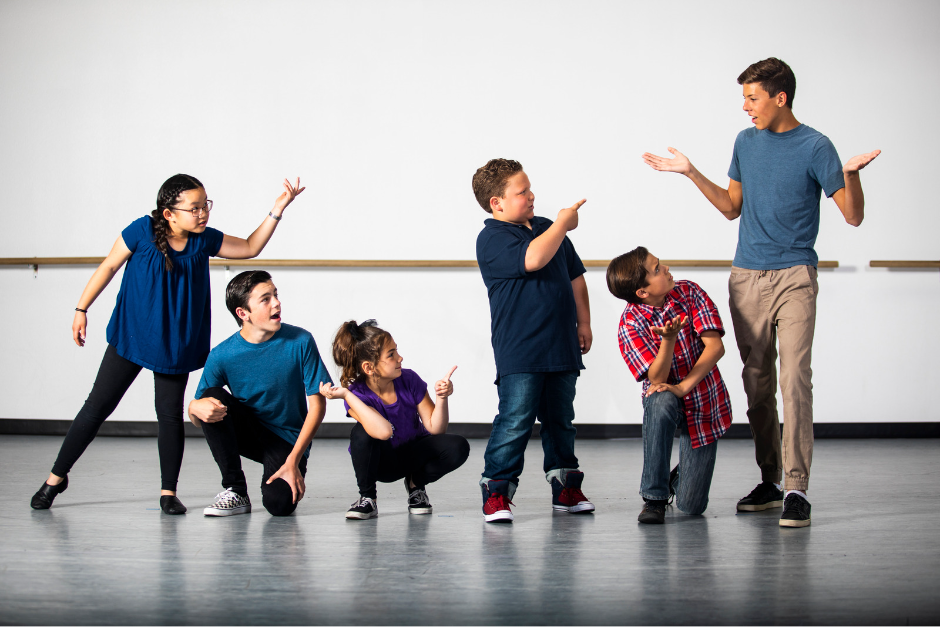English as a foreign language (EFL) classes can sometimes be dry and boring, especially for students who struggle with the language. But incorporating drama into your lessons can not only make them more engaging but also help students improve their English skills. In this post, I'll explore the benefits of using drama in EFL classes and provide some tips and ideas for teachers to get started.
Benefits of Incorporating Drama Techniques and Activities into EFL Lessons
 Drama can offer several advantages to EFL students, including improved language acquisition, increased confidence, and enhanced creativity. Through drama, students can practice their speaking and listening skills in a fun and immersive way. By using English in a dramatic context, students are exposed to new vocabulary and grammar structures in a meaningful way, making it easier for them to retain the information. Additionally, drama provides a safe and supportive environment for students to practice their public speaking skills and become more comfortable expressing themselves in English. This can help students build their confidence and overcome any fear or hesitation they may have about speaking English in front of their peers. I’d like to suggest giving more space to the rehearsal stage as much as possible in your lessons integrated with drama activities. The rehearsal stage is a safer place for many students who are reluctant to speak English. They will be more relaxed with their peers when trying to perform in a language they have just begun to use.
Drama can offer several advantages to EFL students, including improved language acquisition, increased confidence, and enhanced creativity. Through drama, students can practice their speaking and listening skills in a fun and immersive way. By using English in a dramatic context, students are exposed to new vocabulary and grammar structures in a meaningful way, making it easier for them to retain the information. Additionally, drama provides a safe and supportive environment for students to practice their public speaking skills and become more comfortable expressing themselves in English. This can help students build their confidence and overcome any fear or hesitation they may have about speaking English in front of their peers. I’d like to suggest giving more space to the rehearsal stage as much as possible in your lessons integrated with drama activities. The rehearsal stage is a safer place for many students who are reluctant to speak English. They will be more relaxed with their peers when trying to perform in a language they have just begun to use.
Furthermore, drama encourages creativity and critical thinking skills in students. Through drama activities, students can explore different scenarios, characters, and emotions, allowing them to develop their imagination and think outside the box. Drama also encourages collaboration and teamwork among students, as they work together to create scenes and performances. These skills are essential for success in all areas of life, making drama a valuable tool for EFL students. Teachers can incorporate drama into their lessons by starting with simple role-play activities and gradually increasing the complexity as students become more comfortable. Additionally, they can use authentic materials, encourage participation, and provide feedback to help students improve their language skills and performance.
Three Engaging Drama Activities for Young Learners
Now, I’d like to share three different well-known drama activities with my little touch. They will work best with young learners in beginner classes. However, they can be incorporated with students at different levels, including older ones, when you adjust certain aspects of these activities, such as the language or commands.
You should use the scaffolding technique when you present these activities in your classes. Scaffolding or gradual introduction is a technique often used in drama to help learners build their skills and confidence over time. By breaking down complex activities into smaller, more manageable steps, learners can gradually build their understanding and mastery of the activity. This technique can be particularly effective for young learners or those who are new to drama activities. By introducing new stages or figures step by step, learners can focus on mastering each step before moving on to the next one, leading to a more effective and enjoyable learning experience.
Get into Line: This is a fun activity that challenges students to form a line based on specific criteria, such as name or birth date. The twist is that they can only ask one question and use nonverbal communication to do so within a time limit. Students have to work together to figure out the criteria and arrange themselves in the right order.
Usually, even with classes that have good teamwork skills, they can't complete the task in time. I normally give them three minutes, which is reasonable. If they can't do it in three minutes, I give them an extra minute or more. I also watch them to make sure they don't touch each other to move them in line. They should organize themselves to get into a straight line by using hand gestures like pointing or nodding after learning their names or birth dates.
If your class consists of very young learners, you can teach them months or fruits first. Then they can form a line according to their birth months or favourite fruits. They ask each other for their names and make a line in alphabetical order. Then they ask each other for their birth months (and dates if they are the same) or favourite fruits and make a line in chronological or alphabetical order. This activity is a great ice-breaker and helps build good rapport in class.
False Commands: This is a fun activity that involves students moving around in the classroom. You start by telling them to walk at different speeds according to the numbers you say, from 1 to 10. The higher the number, the faster they walk, and the lower the number, the slower they walk. For example, when you say "walk 5", they walk at a normal speed, and when you say "walk 8", they walk faster.
Next, you add some more commands to make it more interesting. You can say "go", "stop", "snap", "clap", "jump", or "smile at people" while they are walking. They have to follow your commands as soon as they hear them. The trick is to introduce the commands one by one and make sure they understand them before adding another one.
Finally, you make it more challenging by swapping the commands. For example, when you say "go", they have to stop, and when you say "clap", they have to snap. The swapped commands can be: "Go" means "stop", "clap" means "snap", and "jump" means "smile at people". They have to follow the swapped commands now. Again, you should introduce them gradually and check their comprehension.
This activity is great for practising listening skills, following instructions, and having fun in the classroom. You’ll be amazed by the fun the students are having when false commands are introduced.
Feeling Cards: This activity has four main steps. The first one is disappearing dialogues, then teaching feelings, rehearsing the dialogues with the chosen feeling cards and lastly staging the dialogues for guessing the chosen feeling card.
At first, you’ll write a short dialogue with your students on the board. Make up a simple dialogue by giving them prompts like “a question about favourite things, a question using ‘like’ or suggest going out or watching a film together with your friend.” After forming the dialogue on the board, start dictating the dialogue on the board. Each time after you dictate the dialogue, you should delete some parts of the dialogue. After the fifth or sixth dictation, you should have deleted all the dialogue on the board. The class will be saying all the dialogue chorally without any words on the board. This part is a really fun time in class.
After that, present flashcards of feelings to students. Check whether they have understood the feeling in the picture and drill it so that they become more familiar with them.
Then, ask your students to choose one of the feeling cards and make pairs of students to play the dialogue with the chosen feeling card. For example, if the pair of students have chosen the “sad” and “happy” feeling cards then the students should act out the dialogue according to their feeling cards. This is the rehearsal stage before playing it in front of the class.
At last, they play the dialogue in front of the class and other students try to guess the acted-out feelings. This activity is great for practising speaking skills and expressing emotions. You can download the flashcards for teaching below.
Drama is a powerful tool that can be used to engage students, improve their English skills, and boost their confidence. It is an enjoyable experience for both students and teachers. By incorporating drama into your EFL lessons, you can create a more dynamic and interactive learning environment that will help your students succeed.
Happy teaching with drama!
This blog post is co-created with an LLM chatbot.
| Attachment | Size |
|---|---|
| 520.97 KB |






